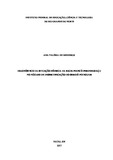Diagnóstico da situação hídrica da bacia Piancó-Piranhas-Açu no Núcleo de Desertificação do Seridó Potiguar

Visualizar/
Data
2017-08-30Autor
Medeiros, Ana Valéria de
http://lattes.cnpq.br/4429628458154800
Metadado
Mostrar registro completoResumo
Water is vital to the survival of all species and decisive for the quality of peoples´ living standards and conditions on the current climate change. However, all concerns about quantity and quality are a reality for the semi-arid and desertification areas, particularly for the Northeast of Brazil, in the face of water scarcity and environmental degradation, and lack of knowledge about water resources assessment through the use of indicators that analyze environmental problems. Therefore, this study aims to diagnose the situation of water resources in the basin of Piancó-Piranhas-Açu river, in the Center for Desertification of Rio Grande do Norte Seridó stretch, using the indicators matrix Driving Force, Pressure, State, Impact and Response (DPSIR) for planning and decision-making purposes. Therefore, the following methodological procedures were adopted: survey and analysis of the main theoretical supports, research of secondary data in public agencies and field research, carried out in the municipalities of the Seridó Desertification Nucleus (SDN), since it is the territorial area of the basin more fragile and affected by water scarcity. From the application of FPEIR, the evaluation diagnosis of water resources of the basin was based on thirty (30) indicators spread over Driving Force (6), Pressure (5), State (5), Impact (2) and Response (12). The results showed the fragility of water resources in terms of quality and quantity, and the driving forces and pressures with high capacity change of resources; status indicators, impact and response are characterized as worrying especially in terms of water production and groundwater potability; conflicts of use of water resources; the destination of waste; the monitoring of surface and underground resources; and, collection and treatment of sewage. It is concluded that the matrix of DPSIR indicators was an important tool for the analysis of the environmental problems of the basin, more precisely in the section of SDN, as well as information essential to the preparation of proposals for planning and management of water resources and as a subsidy to Public managers and civil society for more sustainable decision-making.



